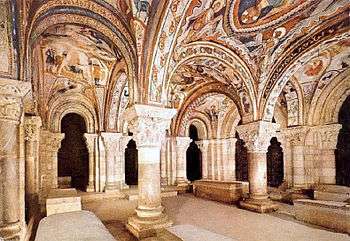Sancha of León
| Sancha | |
|---|---|
|
Empress of All Spain Queen of León | |
 18th-century Statue in the Royal Palace of Madrid | |
| Born | c.1018 |
| Died | 27 November 1067 |
| Burial | Basilica of San Isidoro |
| Spouse | Ferdinand I of León[1] |
| Issue |
Urraca of Zamora Sancho II Elvira of Toro Alfonso VI García II |
| House | Astur-Leonese dynasty |
| Father | Alfonso V of León |
| Mother | Elvira Menéndez |
| Religion | Roman Catholicism |
Sancha of León (c. 1018[2] – 27 November 1067) was a Queen of León.
Life
Sancha was a daughter of Alfonso V of León by his first wife, Elvira Menéndez.[2] She became a secular abbess of the Monastery of San Pelayo.
In 1029, a political marriage was arranged between her and count García Sánchez of Castile.[3] However, having traveled to León for the marriage, García was assassinated by a group of disgruntled vassals. In 1032, Sancha was married to García’s nephew and successor, Ferdinand I of León and Castile.
At the Battle of Tamarón in 1037 Ferdinand killed Sancha’s brother[4] Bermudo III of León,[5] making Sancha the heir and allowing Ferdinand to have himself crowned King of León, Sancha thereby became Queen. Following Ferdinand’s 1065 death and the division of her husband’s kingdom, she is said to have played the futile role of peacemaker among her sons.
She was a devout Catholic, who, with her husband, commissioned the crucifix that bears their name[6] as a gift for the Basilica of San Isidoro.[7]
Children
Sancha had five children:
Death and burial

She died in the city of León on 27 November 1067. She was interred in the Royal Pantheon of the Basilica of San Isidoro, along with her parents, brother, husband, and her children Elvira, Urraca and García.
The following Latin inscription was carved in the tomb in which were deposited the remains of Queen Sancha:
"H. R. SANCIA REGINA TOTIUS HISPANIAE, MAGNI REGIS FERDINANDI UXOR. FILIA REGIS ADEFONSI, QUI POPULAVIT LEGIONEM POS DESTRUCTIONEM ALMANZOR. OBIIT ERA MCVIII. III N. M."
Which translates to:
"Here lies Sancha, Queen of All Spain, wife of the great king Ferdinand and daughter of king Alfonso, who populated León after the destruction of Almanzor. Died 3 November 1108."
References
- ↑ Martínez Díez, Gonzalo. Sancho III el Mayor: Rey de Pamplona, Rex Ibericus. Madrid: Marcial Pons Historia, 2007.
- 1 2 Sánchez Candeira 1999, p. 48.
- ↑ Bernard F. Reilly, 26.
- ↑ Justo Pérez de Urbel and Ricardo Del Arco y Garay, Historia de España, vol. 6, España cristiana, comienzo de la reconquista (711-I038), 2d ed.
- ↑ Reilly, Bernard F. 1982. The Kingdom of León-Castilla under Queen Urraca, 1109–1126, 3. Princeton: Princeton University Press.
- ↑ Gómez-Moreno, María Elena (1947). Mil Joyas del Arte Español. Barcelona: Instituto Gallach.
- ↑ Sureda, Joan (1988). Historia Universal del Arte: Románico/Gótico. Barcelona: Editorial Planeta
- ↑ Sánchez Candeira 1999, p. 226.
- 1 2 3 4 Sánchez Candeira 1999, p. 227.
Bibliography
- Blanco Lozano, Pilar. Colección diplomática de Fernando I (1037–1065). León: Centro de Estudios e Investigación «San Isidoro» (CSIC-CECEL) y Archivo Histórico Diocesano, 1987. ISBN 84-00-06653-7.
- Sánchez Candeira, Alfonso (1999) [1950]. Rosa Montero Tejada, ed. Castilla y León en el siglo XI, estudio del reinado de Fernando I (in Spanish). Madrid: Real Academia de la Historia. ISBN 978-84-8951241-2.
| Preceded by Urraca Gómez |
Countess of Castile 1032–1037 |
Succeeded by Title superseded |
| Preceded by New Creation |
Queen of Castile 1037–1065 |
Succeeded by Alberta, Queen of Castile |
| Preceded by Jimena of Castile |
Queen of León 1037–1065 |
Succeeded by Agnes of Aquitaine |
| Preceded by Muniadona of Castile |
Empress of Spain 1056–1065 |
| Wikimedia Commons has media related to Sancha of León. |